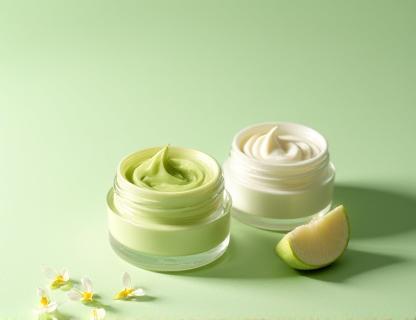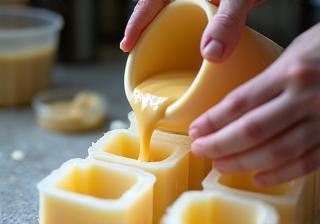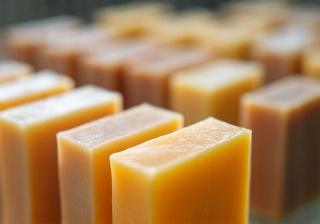Experience Nature's Touch with Bilka & Raka Cosmetics
Artisan Handmade Cosmetics Crafted with Care in Bulgaria
Request a Custom QuoteOur Story & Philosophy
Our journey began nestled in the vibrant cultural heart of Plovdiv, Bulgaria, a land steeped in tradition and blessed with abundant natural flora. Bilka & Raka Cosmetics was born from a deep-rooted passion for harnessing the potent, gentle power of local herbs and botanical extracts to create skincare that is both effective and kind to the earth. We hold a firm belief in the timeless wisdom of traditional craftsmanship, meticulously combining it with contemporary dermatological insights focused on natural ingredients. Every single product we offer is lovingly brought to life by hand in small, carefully managed batches. This artisanal approach ensures unparalleled quality, meticulous attention to detail, and the ability to infuse each item with genuine care and positive energy. Unlike mass-produced cosmetics, our small-batch method allows us to maintain stringent quality control at every step, from ingredient selection to final packaging.
Our core mission transcends mere skincare; it's about fostering a harmonious relationship between people and nature. We are dedicated to providing natural, sustainable cosmetic solutions that not only nurture and rejuvenate your skin but also respect and protect our precious planet. We conscientiously source the finest local herbs, known for their incredible efficacy, alongside high-quality, ethically produced natural oils and butters. This commitment means we strictly avoid harsh chemicals, synthetic fragrances, parabens, sulfates, and other additives that can irritate the skin and harm the environment. By choosing Bilka & Raka, you embark on a transformative journey towards healthier, more radiant, and balanced skin, achieved through the pure goodness of nature. We invite you to experience the difference that true handcrafted care and potent natural ingredients can make.


Our Natural Cosmetic Offerings
We specialize in a range of handmade natural products and offer custom manufacturing solutions tailored to your business needs:

Artisan Handmade Soaps
Our signature handmade soaps are lovingly crafted using the traditional cold-process method, preserving the integrity and beneficial properties of the natural oils, botanical extracts, and pure essential oils we use. Each bar is a unique piece of art, offering luxurious lather and nourishment for all skin types. Available for individual retail purchase and custom bulk orders for businesses looking for high-quality, natural soap solutions.

Herbal Creams and Lotions
Experience the deep hydration and soothing power of our herbal creams and lotions. Formulated with potent extracts from Bulgarian herbs like chamomile, calendula, and lavender, combined with nourishing natural butters and oils, these products are perfect for revitalizing and protecting your skin. We also offer custom formulation services for businesses seeking unique, natural skincare products tailored to their brand.

Artisanal Bath & Body Products
Transform your daily routine into a spa-like indulgence with our exquisite range of bath and body products. From effervescent bath bombs infused with essential oils and botanicals to exfoliating body scrubs made with natural exfoliants and intensely moisturizing body butters, every product is designed to nourish your skin and uplift your senses using only the finest natural ingredients.

Essential Oil Blends
Unlock the therapeutic and aromatic benefits of pure essential oils with our carefully curated blends. Formulated by experienced practitioners, our blends are perfect for aromatherapy using diffusers or diluted for topical application. We offer a variety of blends targeting different needs, from relaxation to invigoration, and can provide wholesale options for retailers and wellness businesses.

Personalized Gift Sets
Share the gift of natural well-being with our beautifully packaged personalized gift sets. Perfect for corporate gifting, special events, or thoughtful presents for loved ones, these sets can be customized with a selection of our finest products. We work with you to create unique and memorable gifts that reflect your appreciation for quality and natural care.

Custom Manufacturing & Wholesale
Partner with Bilka & Raka Cosmetics to bring your vision for a natural cosmetic line to life. We offer comprehensive custom formulation and private label manufacturing services, leveraging our expertise in natural ingredients and handcrafted production. Alternatively, you can order our existing products in bulk under your own brand. We provide flexible solutions to support businesses of all sizes. Learn More about Partnership Opportunities
Ingredients We Cherish
We carefully select potent, natural ingredients known for their exceptional beneficial properties, often sourced locally from the rich Bulgarian land:

Bulgarian Rose Oil
Renowned globally, Bulgarian Rose Oil is a precious elixir famous for its powerful soothing, anti-inflammatory, and regenerative properties. It helps calm irritated skin, reduce redness, and promote a youthful complexion, offering a delicate, uplifting aroma.

Chamomile Extract
A gentle yet potent botanical, Chamomile Extract is a skincare hero, particularly for sensitive and easily irritated skin. Its calming and anti-inflammatory benefits help to soothe discomfort, reduce puffiness, and promote a balanced, serene complexion.

Calendula Oil
Derived from the bright calendula flower, this oil is a fantastic aid for skin healing and regeneration. Rich in antioxidants and anti-inflammatory compounds, Calendula Oil helps to soothe wounds, reduce scars, and support the skin's natural repair processes.

Olive Oil
A Mediterranean staple, Olive Oil is a deeply moisturizing ingredient, packed with beneficial fatty acids and powerful antioxidants like Vitamin E. It helps to nourish and hydrate the skin, protect against environmental damage, and improve overall skin health and texture.

Shea Butter
Harvested from the nuts of the African shea tree, Shea Butter is an intensely hydrating and emollient natural butter. It's rich in vitamins A and E and essential fatty acids, helping to soften the skin, improve elasticity, and provide a protective barrier against moisture loss.
Our Handcrafted Process
From selecting the finest botanicals to the final packaging, every step in creating Bilka & Raka cosmetics is performed with meticulous care and dedication:

1. Sourcing Natural Ingredients
Our commitment to quality begins at the source. We meticulously select the finest natural herbs, botanical extracts, pure essential oils, and nourishing butters and oils. We prioritize suppliers who share our values, focusing on local Bulgarian sources for ingredients like rose oil and specific herbs, and ethically sourced, sustainable options for global botanicals, ensuring purity and potency in every batch.

2. Small Batch Formulation
Our experienced formulators, blending traditional knowledge with scientific expertise, carefully craft each recipe. We work exclusively in small batches. This allows us maximum control over the process, ensuring consistent quality, texture, and efficacy. It also means that our products are fresh when they reach you, packed with the active benefits of the natural ingredients.

3. Handcrafting with Care
This is where the heart of our work lies. Soaps are hand-poured into molds, creams are lovingly whipped to perfect consistency, and balms are carefully blended. Every step of the creation process is performed by skilled hands using traditional artisan techniques passed down through generations, ensuring that each product receives individual attention and care, making it truly unique.

4. Curing and Quality Check
For products like our cold-process soaps, a natural curing period is essential. This allows the soap to harden and milden, resulting in a superior, long-lasting bar. Before any product leaves our workshop, it undergoes rigorous quality checks to ensure it meets our high standards for appearance, texture, scent, and performance, guaranteeing you receive only the best.

5. Mindful Packaging
Our commitment to sustainability extends to our packaging. We use minimal and eco-friendly materials whenever possible, opting for glass, paper, or recyclable plastics. Each product is mindfully packaged by hand, ensuring it is protected during transit while minimizing our environmental footprint. We believe in beauty that is good for you and good for the planet.
What Our Clients Say

Maria Petrova
Plovdiv, Bulgaria
"Bilka & Raka's natural soaps have truly transformed my skincare routine! My skin feels incredibly soft, nourished, and balanced since I started using them. The scents are divine and purely from nature. I can finally wash my face without that tight, dry feeling. Absolutely amazing!"

Ivan Ivanov
Event Manager
"We partnered with Bilka & Raka Cosmetics for custom gift sets for our recent corporate event, and the entire experience was seamless. The quality of the products was exceptional, beautifully packaged, and our guests were absolutely delighted. Their team was professional, responsive, and easy to work with. Highly recommend for corporate gifting!"

Elena Georgieva
Customer
"As someone with very sensitive skin prone to redness and irritation, finding suitable skincare has always been a struggle. Their herbal creams are a miracle! They are so gentle, incredibly soothing, and effectively calm my skin without causing any breakouts or discomfort. It's the only brand I trust for my sensitive skin now."

Dimitar Kostov
Customer
"I bought a selection of bath bombs and body butters from Bilka & Raka, and the quality is outstanding. The ingredients feel so luxurious and natural, and the scents are just heavenly without being overwhelming. It truly elevates my bath time into a relaxing retreat. Highly recommend for anyone looking for natural indulgence."

Ani Stoyanova
Spa Owner
"We integrated Bilka & Raka's essential oil blends and massage oils into our spa treatments, and the feedback from our clients has been overwhelmingly positive. The purity and quality of their oils are noticeable, and the natural aromas create a truly therapeutic atmosphere. A valuable partnership for our wellness business."

Petar Vasilev
New Brand Owner
"Starting our own natural cosmetic brand felt daunting, but Bilka & Raka's custom manufacturing service made it possible. They guided us through formulation, sourcing, and production with expertise and transparency. The resulting products are exactly what we envisioned – high quality, natural, and beautifully made. They are true partners."
Frequently Asked Questions
Get in Touch or Request a Quote
Interested in our luxurious natural products for personal use, or exploring partnership opportunities for custom manufacturing or wholesale? Fill out the form below with your inquiry, or contact us directly via phone or email. We look forward to hearing from you!
Send Us a Message
Contact Information
- Phone: +359 88 123 4567
- Email: info@bilkaandrakacosmetics.com
- Address: 21 ul. Raiko Daskalov, 4000 Plovdiv, Plovdiv Province, Bulgaria
- View on Map